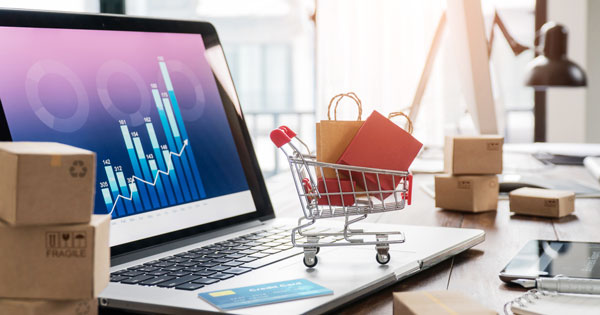
by Alexander Igelsböck
The pandemic has created tough challenges for retailers, often hitting independent players hardest of all. Along with falling foot traffic, economic uncertainty, and closer scrutiny of marketing budgets have come opportunities to evolve and improve their businesses for the digital future.
Rapid growth in online purchasing has sparked an unprecedented ecommerce boom, with global sales rising to $4 billion and the U.S. market exceeding $1 billion. As a result, smaller retailers are being pushed into a wider world of digital possibilities where they can expand their reach beyond brick-and-mortar stores to engage bigger audiences across multiple channels.
Tapping ecommerce potential, however, means competing with established giants, and that calls for smarter marketing and a better knowledge of the online space. Real-time understanding of what is working and what is not will be essential to decide where spend should be allocated for maximum impact, and to squeeze optimal efficiency out of every cent.
Achieving this will involve taking lessons from the big players by following their analytical example: switching from outmoded and reactive data-driven analysis to an insight-driven approach exemplified by augmented analytics and powered by artificial intelligence (AI). That is not to say this is a case of all or nothing and that in the case of every independent and smaller retailer, it is necessary to jump from zero to one hundred in terms of capability.
Making the move from minimal-or-no analytics to AI-driven augmented analytics can be a big leap, especially for operations that depend on just one or two people utilizing manual reporting to look after their online presence. Here, having a single source of truth across all acquisition channels may feel unrelatable, or even intimidating, and so adopting a pragmatic and incremental approach with consideration to a retailer’s particular circumstances is paramount.
Unleashing Insight with Augmented Analytics
Many independent retailers have already started their digital shift via BOPIS: the buy online, pick up in store phenomenon is seeing surges in adoption of up to 259 percent, but with ecommerce acceleration now moving five years ahead of schedule, they must go further, and faster. Securing long-term success will mean not just boosting online services, but also unlocking the intelligence in data to fuel agile operations and marketing strategies.
A significant evolution from conventional analysis, augmented analytics allows retailers to harness vital insights before they get lost in the ‘data haystack’, and without spending hours manually wading through complex data sets and dashboards. This includes using AI-based assessment to generate granular reports that provide the ability to consistently track and improve outcomes, as well as instant detection of anomalies and trends they may otherwise have missed.
Ultimately, this means retailers will have quick answers to questions about both current performance and the road ahead, helping them keep pace with competitors, ever-changing customer needs, and the unpredictable global climate.
Diving Deep to Super-Charge Performance
Whether an overnight or incremental adopter, the actionable insights produced by augmented analytics give retailers the means to spot and proactively leverage opportunities for performance enhancement in multiple areas. From a sales perspective, for instance, they can run refined reports to pinpoint which channels, marketplaces or search engines are driving the highest sales. Drilling down even deeper, they can also analyze sales for specific product SKUs, locations, and retail partners – with automated unification and harmonization allowing for streamlined cross-network comparisons of like-for-like results, even if different partners use varying formats.
Such detailed information will provide the insights needed to determine how and where operations require adjustment to keep the supply chain running smoothly and make sure desirable items are in stock when demand peaks. This is especially key in the face of impending ‘shipageddon’ — the explosion of package deliveries resulting from the surge in ecommerce sales over the holiday season. Moreover, when seamlessly integrated with advertising data, it can also be used to create all-encompassing marketing reports.
Instead of relying on historic data to guide campaigns and promotions, retailers can gain a precise view of the impact marketing efforts are making right now, in terms of conversions and overall return on ad spend (ROAS). Applying extra segmentation to identify the most profitable creative assets, products and customers can then pave the way for in-flight optimization, especially when combined with sophisticated forecasting that calculates the effect of increasing or decreasing spend for high and low performers and adjusts budget distribution accordingly.
Bringing the Future Into Clearer Focus
The capacity of augmented analytics to make the future less of an unknown quantity also makes it easier for retailers to stay nimble to whatever changes may come. For example, when deployed to uncover anomalies across varied data pools, it can be a valuable tool for driving pre-emptive action. Using algorithms that self-learn from past key performance indicators (KPIs), it monitors where marketing campaigns should be in terms of maximizing ROI — instantly flagging discrepancies, such as irregularities in customer acquisition or advertising inventory costs. This gives retailers an early warning that allows them to adjust activity and minimize wastage.
Similarly, harnessing intelligent analysis to find developing trends alerts retailers to where they must shift their focus to sustain business success. As well as unearthing unseen patterns or changes buried within huge volumes of KPI data, it can rank them in line with what is most important for each company. This means retailers not only have a clear picture of emerging fluctuations in customer behavior or market conditions, but also a ready-made list of which ones they need to address first.
Retail was becoming increasingly digital before COVID-19. Now that the outbreak has sped up progression, it is clear future-proofing businesses means actively embracing ecommerce. For the small and independent firms that have laid down their roots in physical retail, taking tips from major players to help them thrive in new online territory is key. To stand a chance of competing with seasoned ecommerce players and sustaining success in the constantly evolving market, they will need to swap antiquated data-fuelled strategies for a sophisticated insight-driven method that uses augmented analytics to ensure ongoing agility.
 Alexander Igelsböck is the CEO of Adverity. Data based efficiency has driven every stage of Alex’s career. From the creation, growth and successful exit strategy applied to the multiple companies he has been involved with, to his latest role as co-founder and CEO of marketing data intelligence platform Adverity, powering smarter decisions with proactive analysis remains a key passion for Alex.
Alexander Igelsböck is the CEO of Adverity. Data based efficiency has driven every stage of Alex’s career. From the creation, growth and successful exit strategy applied to the multiple companies he has been involved with, to his latest role as co-founder and CEO of marketing data intelligence platform Adverity, powering smarter decisions with proactive analysis remains a key passion for Alex.
